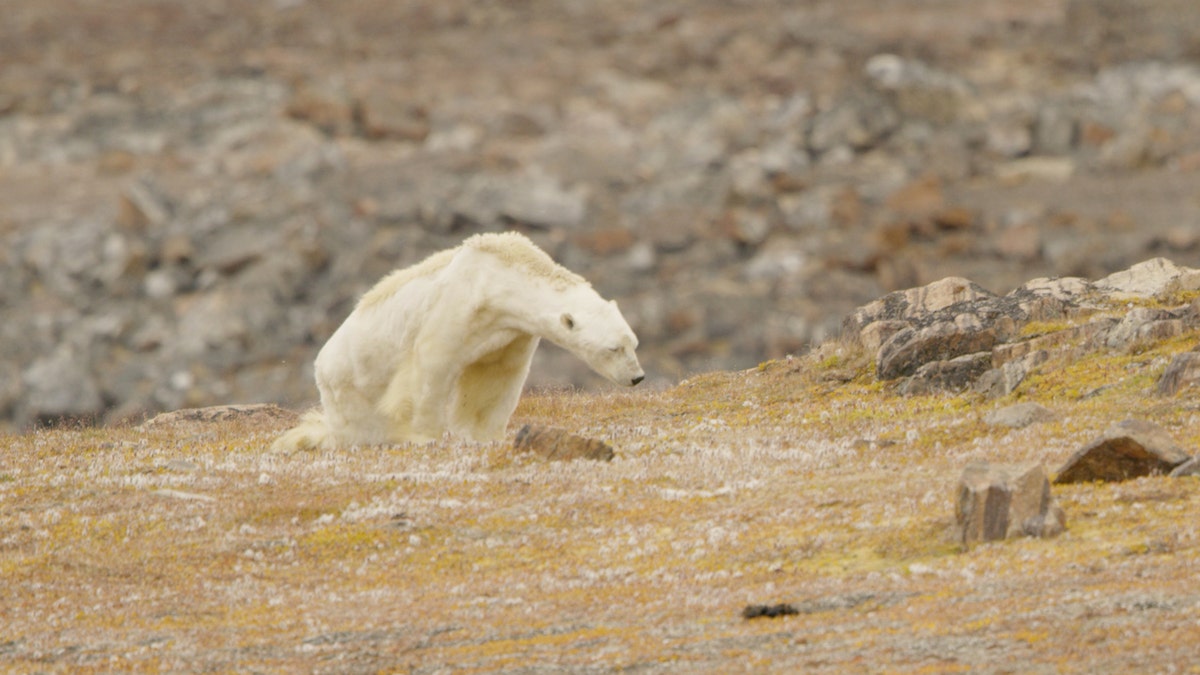
An image of the emaciated polar bear (SEALEGACY / CATERS NEWS)
A video of a starving polar bear recently went viral, tugging at viewers’ heartstrings as the emaciated creature makes its way across an iceless wasteland. Some experts, however, say that the video, which has been seen by millions of people, may not be all that it seems.
National Geographic photographer Paul Nicklen and filmmakers from conservation group Sea Legacy spotted the bear on the Baffin Islands in Canada in late August.
The bear is seen rummaging through a trash can in the video, which has been held up as an illustration of the effects of climate change. “As temperatures rise and sea ice melts, polar bears lose access to the main staple of their diets — seals,” the video explains.
THE STORY BEHIND THAT VIRAL PHOTO OF A LONELY RHINO
However, Nunavut polar bear monitor Leo Ikakhik told CBC that he was not surprised by the sight of the starving bear in the video. "Everybody probably was shocked to see a really skinny bear, but this is not my first time seeing something like this,” he told Carol Off, host of CBC’s radio show "As It Happens."

A video of the starving polar bear has gone viral (SEALEGACY / CATERS NEWS)
Ikakhik, who has been monitoring polar bear activity since 2010, said that the polar bear in the video may have been sick or recovering from an injury that made it unable to hunt. "I wouldn't really blame the climate change. It's just part of the animal, what they go through."
The possibility that the polar bear was ill or aged was also discussed in an article in Canada’s National Post.
VIDEO PURPORTEDLY SHOWS DIVER'S TERRIFYING ENCOUNTER WITH GREAT WHITE SHARK
Sea Legacy co-founder Cristina Mittermeier told "As it Happens" that, while the precise reasons for the bear’s state are unknown, she hopes that the video will prompt discussion about how climate change impacts wildlife.
With the viral video sparking debate, National Geographic posted an article entitled “Your Questions About Our Starving Polar Bear Video Answered” on its website Tuesday.
The article notes that, as a whole, polar bear populations around the world are not in peril. However, citing Steven Amstrup, chief scientist for Polar Bears International, National Geographic reports that “some of the polar bears most at risk of population decline live in regions that have seasonal ice, like that surrounding far northern Baffin Island, where the starving bear was filmed.”
'JAWS' SPOTTED? MASSIVE GREAT WHITE SHARK SIGHTED OFF AUSTRALIAN COAST
“As temperatures warm, seasonal sea ice is melting earlier and coming back later. This extends the time that polar bears must survive on fat alone,” the article explains. “Arctic sea ice covers about a million square fewer miles than it did in 1979. The vast majority of scientists agree that melting sea ice has accelerated beyond the normal rate in the past few decades. The Arctic is one of the regions most impacted by a warming climate.”
In a blog post, Amstrup noted that climate change may not be the main factor contributing to the sad demise of the polar bear in video.
“We cannot say, from the footage captured here, that this bear’s malnutrition was caused by global warming and its associated sea ice loss,” he wrote. “Polar bears have few natural predators. Although they normally live a long time, they are not immortal. All eventually die and most do so because they have not been able to capture enough food. This means that malnutrition is a major cause of death for polar bears.”
'ARBITRARY' ADJUSTMENTS EXAGGERATE SEA LEVEL RISE, STUDY FINDS
However, climate change does pose a very real threat to polar bear populations, Amstrup added. “Despite uncertainties about how this bear got into this starving condition, we can be absolutely certain if we allow the world to continue to warm, there will be ever greater numbers of such events as survival rates decline over more and more of the polar bear range,” Amstrup said. “And we can be certain that, without halting greenhouse gas rise, the world’s polar bears gradually will disappear.”
Follow James Rogers on Twitter @jamesjrogers
